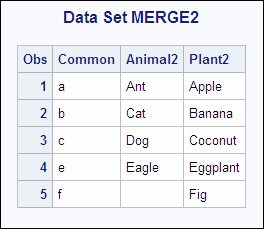

Strings 2.1 Declaring String Variables data string_examples Ģ.2 String Functions 2.2.1 SUBSTRN: extracts a substring using the start and end positions.
Data merge sas deleting records pdf#

PROC PRINT DATA = All_Dept * Print Vertically Merged ITDEPT and NON_ITDEPT ģ.1 Scenarios 3.1.1 Different number of variables DATA ITDEPT ģ.1.2 Different variable name DATA ITDEPT PROC PRINT DATA = NON_ITDEPT * Merged ITDEPT and NON_ITDEPT vertically RUN 2.3 Writing a tab delimited file PROC EXPORT DATA = sashelp.cars OUTFILE = '/folders/myfolders/sasuser.v94/car_tab.txt' DBMS = tab PROC EXPORT DATA = sashelp.cars OUTFILE = '/folders/myfolders/sasuser.v94/car_data_csv.csv' DBMS = csv Write Data Set 2.1 PROC EXPORT PROC EXPORT DATA = sashelp.cars OUTFILE = '/folders/myfolders/sasuser.v94/car_data.txt' DBMS = dlm INPUT Rank Region $ Score GDP_per_capita SS HL_Expectancy Freedom_To_Make_Life_ChoicesĢ. INFILE '/folders/myfolders/World Happiness/2019.csv' dlm="," firstobs=2

INFILE '/folders/myfolders/World Happiness/practice text dataset.txt' firstobs= 2 Read Raw Data 1.1 Reading ASCII(Text) Data Set DATA TEMP But if there are some 1's, then it is the first value=1 date.1. If there are no 1's, then the _cutoff_date is the first value=0 date. If first.category then _cutoff_date=date Set have (where=(value=1) in=firstpass) have (in=secondpass) If you want to keep them all, then the following program will do: If you want to delete them all, then above program works. what do you want to do if a given sub/category has only zeroes? You haven't answer question (or my comment above). In such a case, the program above will drop all obs for that sub/category. What you haven't explained is what you want to do if a given sub/category has no observations with value^=0. So assume data sorted by sub/category/date. This assumes that data are already sorted by sub/category (and presumably you require the data to be sorted by date within each sub/category).

If first.category=1 then _n_of_ones=value You apparently want to delete "leading zeroes" for each sub/category combination.


 0 kommentar(er)
0 kommentar(er)
